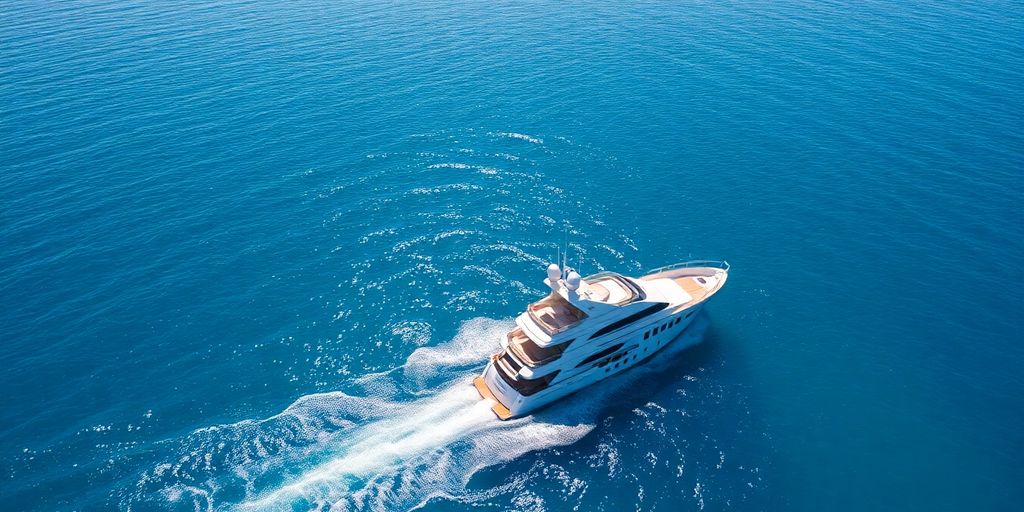When you’re thinking about booking a yacht trip, a big question that pops up is, ‘How long is a charter season?’ It’s not like a regular holiday period that’s the same everywhere. The timing really depends on where you want to go, what the weather’s like, and even what you’re hoping to get out of the trip. Let’s break down what goes into figuring out when the best time to charter is.
Key Takeaways
- A yacht charter season isn’t a fixed global date; it changes based on location, weather, and demand.
- Generally, a yacht charter season lasts about six months, but this can differ a lot by region.
- The Mediterranean season typically runs from spring through fall, while the Caribbean season is usually during winter.
- High season means the best weather and most activity, but also the highest prices, while low season offers lower costs and fewer people.
- Factors like geography, climate, and how popular a place is directly influence how long a charter season lasts.
Understanding Yacht Charter Season Length
When you’re thinking about booking a yacht charter, a big question that pops up is, "How long does the season actually last?" It’s not like a fixed holiday period; the yacht charter season can really change depending on where you want to go, what the weather’s like, and even what you’re hoping to get out of the trip. Let’s break down what makes these seasons tick.
Defining a Yacht Charter Season
A yacht charter season is essentially the period when conditions are considered best for sailing and enjoying a trip on a yacht in a particular location. This isn’t a rigid calendar date but rather a window of opportunity shaped by climate, local events, and demand. Think of it as the prime time when the seas are calm, the temperatures are pleasant, and the destinations are at their most inviting. The duration and timing of these seasons vary dramatically across the globe.
Factors Influencing Season Duration
Several things play a role in how long a charter season lasts:
- Geographical Location: Where the yacht is located makes a huge difference. Tropical spots tend to have warmer weather for longer periods compared to places further north or south.
- Climate and Weather Conditions: This is a big one. Regions prone to hurricanes or heavy rainy seasons will naturally have shorter, more defined charter windows.
- Destination Popularity and Demand: High demand during certain times of the year, often linked to holidays or festivals, can also shape what’s considered the peak season.
How Long Is a Charter Season Typically?
Generally, charter seasons are often divided into three main periods: high, low, and shoulder. The high season is when the weather is usually at its best, but prices are also at their peak. The low season offers more budget-friendly options and fewer crowds, though the weather might be less predictable. The shoulder season sits in between, providing a good balance of decent weather and more reasonable costs. For example, the Mediterranean is ideal for sabbatical yacht charters from April to September, with southern and eastern regions offering year-round warmth. This period provides the best sailing conditions for an extended charter experience in this beautiful region. The Caribbean, on the other hand, typically sees its main season run from December to April, avoiding the wetter summer months and potential hurricane activity.
Regional Variations in Charter Seasons
Mediterranean Charter Season Overview
The Mediterranean yacht charter season is a summer affair, generally kicking off in April and stretching through October. This period offers a fantastic window to explore the diverse coastlines of places like Greece, Italy, Croatia, and the French Riviera. You’ll find the weather is usually quite pleasant, with warm days perfect for enjoying the sea and exploring charming coastal towns. It’s a time when the region is alive with activity, from bustling harbors to local festivals. Many people consider the peak months of July and August to be the heart of the season, though this also means more crowds and higher prices. If you’re looking for a classic European summer experience on the water, this is your window.
Caribbean Charter Season Insights
Across the Atlantic, the Caribbean charter season flips the script, typically running from October to March. This timing is all about escaping the colder weather up north and embracing the tropical warmth. Think crystal-clear waters, vibrant coral reefs, and a laid-back island vibe. Destinations like the British Virgin Islands, St. Barts, and Antigua are popular during these months. The weather is generally dry and sunny, with lower humidity compared to the summer months. It’s a great time for water sports and enjoying the sunshine, and you can often find better deals outside of the absolute peak holiday weeks.
Exploring Other Global Charter Destinations
It’s not just the Med and the Caribbean, though! Yacht charter seasons are happening all over the globe, pretty much year-round. For instance, places like New England in the US have a lovely, albeit shorter, summer season, usually from June to September, with beautiful fall foliage cruises in the early autumn. Then you have destinations in places like Southeast Asia, such as Thailand, where the best chartering conditions are often found during the dry season, typically from November to April. Even places like Australia have their prime charter times depending on the specific region, with Queensland’s Great Barrier Reef being popular during its warmer, drier months. The key takeaway is that yachting season never ends—somewhere in the world, the sails are always up! It really pays to do a little research based on where you dream of sailing.
Seasonal Tiers: High, Low, and Shoulder Periods
When you’re thinking about chartering a yacht, it’s super helpful to know about the different times of year you can go. It’s not just one big block of time; it’s usually broken down into three main parts: high season, low season, and what they call the shoulder season. Each one has its own vibe, price tag, and even weather. Understanding these tiers can really help you pick the best time for your trip.
Characteristics of High Season Charters
High season is basically when everyone wants to be out on the water. Think perfect weather, lots of sunshine, and generally the most pleasant conditions for sailing or cruising. Because so many people are looking to charter during this time, prices tend to go up, and popular spots can get pretty crowded. It’s the peak of tourist season in many places, so expect lively ports and plenty of events happening. If you want the absolute best weather and don’t mind the hustle and bustle (or the higher cost), high season is your time.
Benefits of Low Season Yachting
Now, the low season is the opposite end of the spectrum. This is when demand is at its lowest, which usually means you’ll find the most affordable charter rates. It’s often a quieter time, with fewer people around, making it ideal if you’re looking for a more peaceful and relaxed experience. However, the weather might not be as predictable as during high season, and some places might have limited services or attractions open. It’s a trade-off: lower prices and fewer crowds for potentially less-than-perfect weather.
Navigating the Shoulder Season Advantages
The shoulder season is kind of the sweet spot between high and low. It typically falls in the periods just before or after the peak season. For example, in the Mediterranean, this might be May to June or September to October. In the Caribbean, it could be November or May. The big draw here is that you often get a good mix of decent weather and lower prices than during the high season. Plus, there are usually fewer people around, so you can enjoy a more laid-back atmosphere. It’s a great option if you want to avoid the biggest crowds and save a bit of money without sacrificing too much on the weather. Many people find May to June or September to be fantastic times to charter.
The Impact of Climate on Charter Schedules
When you’re thinking about booking a yacht charter, the weather is probably one of the first things that pops into your head. And for good reason! Climate isn’t just about whether you’ll get a tan; it really shapes when and where you can charter a yacht.
Weather Patterns and Their Influence
Different parts of the world have very different weather. Some places have predictable rainy seasons, while others might face hurricane threats during certain months. For example, the Caribbean has a hurricane season that runs from June to November. Most charter companies and savvy clients tend to avoid this period, especially the peak months of August, September, and October, to stay safe. This naturally shortens the prime charter window there. On the flip side, the Mediterranean generally enjoys a long, sunny season, typically from May through October. However, even here, you’ll find that the weather in May or October can be a bit cooler and less predictable than in the heart of summer. Understanding these typical weather patterns is key to picking the right time for your trip.
Mitigating Risks from Inclement Weather
Nobody wants their dream charter to be ruined by a storm. Responsible charter operators and brokers keep a close eye on forecasts and historical weather data. If bad weather is predicted, they might suggest rescheduling or even changing the itinerary to a safer area. Sometimes, a charter might be cut short if conditions become too rough. It’s all about safety first. For instance, if a hurricane is heading towards your planned destination, the yacht might not even leave the dock, or you might be advised to fly out early. It’s wise to look into travel insurance that covers weather-related disruptions.
Aligning Charters with Ideal Weather
So, how do you make sure you get the best weather for your charter? It really comes down to research and flexibility. Knowing the typical climate for your chosen destination helps a lot. For instance, if you’re dreaming of the Mediterranean, you might find that chartering in late spring or early fall offers pleasant weather without the intense heat and crowds of July and August. This can also mean better prices. As climate change continues to affect traditional patterns, the shoulder months might become even more appealing for yacht charters in regions like the Mediterranean [2378]. Planning your trip around these ideal weather windows means you’re more likely to have smooth sailing and sunny skies.
Key Factors Determining Charter Season Length

So, you’re wondering what actually decides when a yacht charter season kicks off and wraps up? It’s not quite as simple as flipping a switch. Several big things come into play, and understanding them helps you pick the best time for your own trip.
Geographical Location's Role
Where a yacht is located is probably the biggest factor. Think about it: the weather in the Mediterranean is totally different from the Caribbean, right? Each spot has its own climate patterns that naturally create peak times for sailing. For instance, the Mediterranean usually sees its prime charter time from May through October, while the Caribbean has a slightly different rhythm, often peaking from December to April. This geographical difference dictates the kind of weather you can expect and, therefore, when it’s most pleasant and safe to be out on the water.
Climate and Weather Conditions
This ties right into location, but it’s worth breaking down. Extreme weather events can really cut a season short. Places prone to hurricanes, like parts of the Caribbean, will have a defined period when charters are generally avoided to keep everyone safe. Similarly, regions with very cold winters or heavy rainfall will have shorter windows for enjoyable yachting. It’s all about finding that sweet spot where the weather is reliable and enjoyable for sailing and spending time on deck. The Caribbean yacht charter season is a prime example of how weather patterns shape the charter calendar.
Destination Popularity and Demand
Beyond just the weather, how popular a place is also plays a part. If a destination is a hot spot during certain months – maybe because of festivals, holidays, or just general tourist trends – you’ll see higher demand for yachts. This increased demand often means longer peak seasons in those popular areas. When lots of people want to charter in the same place at the same time, companies tend to extend their operating periods to meet that demand, even if the weather is just okay. It’s a bit of a balancing act between what’s ideal weather-wise and what people actually want to do.
Planning Your Yacht Charter Around Seasonality

So, you’ve got the yacht picked out, and you’re dreaming of the open water. But when exactly is the best time to actually go? Planning your yacht charter around the seasons is a big part of making sure your trip is everything you hoped for. It’s not just about picking a date; it’s about understanding what each part of the year offers in different parts of the world.
Choosing the Best Time to Charter
When you’re figuring out the best time to book your charter, think about what you want from the trip. Are you looking for non-stop sunshine and buzzing beach clubs, or do you prefer a more laid-back vibe with fewer crowds? The weather plays a huge role, of course, but so does what’s happening on land. Some destinations really shine during specific months, offering unique festivals or events that might be a big draw for you. It’s all about matching your expectations with what the destination can realistically offer during a particular time of year. For instance, if you’re eyeing a Mediterranean adventure, you might find that late summer and early fall are fantastic times to explore, with pleasant weather and fewer people around than in the peak summer months. You can find some great spots for late summer travel here.
Balancing Weather and Cost
This is where things get interesting. High season usually means the best weather – think clear skies and calm seas – but it also comes with the highest price tags. If your budget is a bit tighter, or you’re just not a fan of big crowds, then looking at the shoulder seasons (spring and fall) or even the low season can be a smart move. You might trade a few degrees of warmth or deal with a bit more wind, but you’ll often find significantly lower charter rates and a more relaxed atmosphere. It’s a trade-off, for sure, but one that can make a luxury yachting experience much more accessible.
When Is the Best Time to Visit the Mediterranean?
For the Mediterranean, the classic high season runs from June through August. This is when the weather is reliably hot and sunny, perfect for swimming, sunbathing, and enjoying all the coastal towns have to offer. However, it’s also the busiest and most expensive time. Many people find that May and September offer a fantastic sweet spot. The weather is still beautiful, often warm and pleasant, but the crowds thin out considerably, and prices tend to drop a bit. October can also be lovely, though the weather becomes a bit more unpredictable as the season winds down. So, if you want a good mix of great weather, fewer people, and slightly better value, aiming for May, September, or even early October is often a winning strategy.
So, What's the Takeaway?
Ultimately, figuring out how long a yacht charter season lasts really boils down to where you want to go and when. It’s not a one-size-fits-all deal. Whether you’re dreaming of the Mediterranean’s sunny shores or the Caribbean’s warm waters, each spot has its own rhythm. Keep in mind things like the weather, how busy it gets, and what you’re hoping to get out of your trip. By looking at the different seasons – the busy high times, the quieter shoulder months, and the off-peak periods – you can pick the perfect time for your own adventure. Don’t forget, the world of yachting is always moving, so there’s always somewhere with good sailing conditions happening.
Frequently Asked Questions
What exactly is a yacht charter season?
A yacht charter season is the best time of year to rent a yacht for a trip. It’s when the weather is usually great for sailing and enjoying the water. Think of it like the ‘best time to go’ for a specific place.
How many main yacht charter seasons are there in a year?
Generally, there are two main times for yacht charters: the Mediterranean season, which is usually from spring to fall, and the Caribbean season, which is during the winter. But other places have their own special times based on their weather.
How long does a yacht season usually last?
Most yacht seasons last about six months. However, this can change a lot depending on where you want to go. Some places might have longer or shorter good times for chartering.
When is the ideal time to visit the Mediterranean?
The best times to visit the Mediterranean are usually in late spring or early fall, like May, June, September, and October. The weather is nice, there aren’t as many people, and it’s perfect for seeing the beautiful coasts and islands.
What main things decide how long a yacht charter season is?
The length of a yacht season depends on things like where it is, what the weather is like, and how popular that place is for tourists. For example, tropical places might have longer seasons than places with very different seasons.
Does weather affect how long a yacht charter season lasts?
Yes, weather is a big deal! If a place often has bad weather like hurricanes, the season will be shorter and planned carefully to avoid those times. Safety is super important, so charter companies avoid risky weather.



